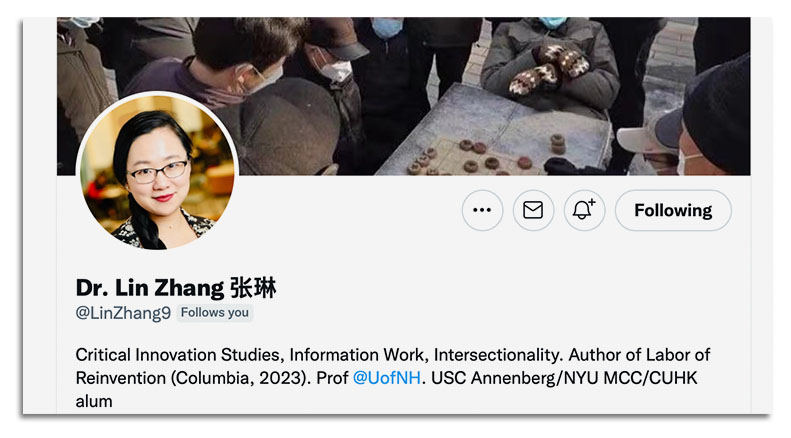A U.S. UNIVERSITY LECTURER who expressed despair at the impossibility of fighting negative media “framing” of China got a nice surprise today. A range of supportive voices on social media encouraged her not to quit.
A few hours ago, Dr Lin Zhang of the University of New Hampshire posted a sad lament on Twitter, saying that she felt like giving up her attempt to teach young people about China, when all media sources they read reflected the hostile, distorted view from Washington DC.
“How do you teach China today in American classrooms and don’t get depressed over all the student presentations repeating all the cultural stereotypes and DC positions after all the work you put in to complicating their understanding beyond media framing?” she asked.
They retained the media-framed “China bad” positions leaving her feeling that she “failed as a teacher”.

Dr Lin told the story of how one student went to the front of the class to do a presentation and asked the others: “Why do you think all the media coverage of China in the US is so negative?”
The classroom was completely silent.
The young woman answered her own question: “The answer is that the coverage is bad because there’s a bipartisan consensus in the US that China is bad.”
Dr Lin said: “That moment, I realized, I should probably stop teaching China and just let it go. Who wants the fight the bipartisan consensus?” The “whole system in the US”, left and right, politicians and media, are working together to demonize the Chinese, she realized.
OUTPOURING OF SYMPATHY
Her sad confession saw an outpouring of sympathy on social media.
“That is rough. Wish I knew the answer!” said Ben Smith, a neuroscientist from Oregon. “I think working to move the dial can make a difference even when you can’t see it. It can take a few cumulative collisions with evidence for people to change their minds.”
Army chaplain Jonathan Bailey encouraged Dr Lin to realize what a crucial job she was doing. “This is a really important question, and I’m sorry your students aren’t grasping how important it is. Don’t lose heart; you never know when the light may turn on for someone.”
Several people said that it was difficult to keep telling the truth about China in the face of such powerful “state-sponsored” propaganda, but it had to be done.
“Tough to answer given the current state of affairs, and the rancor that exists between China and the US right now, but that’s the job,” said Richard Brubaker, an Asian sustainability specialist. “And sorry, it’s on you to help your students navigate this time better so that the pattern is broken.”
Another university teacher simply admitted that the battle was impossibly difficult. “I drink my way thru modern China teaching semesters if I’m honest,” said Dr Glenda Ellen Chao, a professor of East Asian history.
THE MOMENT EVERYTHING CHANGED
Background: China was well-liked in the United States until 2017, when the world’s most populous country wasn’t even in the list of America’s “perceived enemies” (see chart below).
But 2018 saw a series of closed door meetings of the intelligence agencies of the U.S., UK, Canada, Australia, New Zealand, Germany and Japan to prepare a new “China containment strategy”.
Over the following years, these agencies fed an endless torrent of negative stories to the international media to portray China as “destroying” Xinjiang, Hong Kong, and Tibet, and being on the verge of invading Taiwan and Australia. The campaign has been wildly successful, as you can see this chart—and it is continuing to be successful.

It’s long been known that intelligence and news media agencies work together to “manufacture consent” for public money to be diverted to warfare. As far as these students go, “it appears their consent has already been manufactured,” said Yichen Yao, who works for a military veterans organization in New York.
FIGHTING THE BATTLE
A Chinese source named Bevin, who describes himself as a “wolf warrior”, said: “Bias confirmation is nearly impossible to overcome, and if reinforced by subliminal anti-Chinese racism, even more so.”
Mike Soha, a lecturer in media studies in Boston, said he showed his students movies or TV shows, where the bias was easier to see – and then helped them to identify the same elements in the media. “In my News Analysis class, I use war films with exaggerated ideological frames that are easy to identify and deconstruct, and then work backwards to news framing and that sort of thing.”
Dr Lin responded to her social media followers with an item of positive news. She said that she had received feedback from one student who appeared to have got the message, saying: “It’s eye-opening that there are not enough facts out on certain topics of China from China’s point of view.”
Photo at the top by Douglas Lopez on Unsplash
